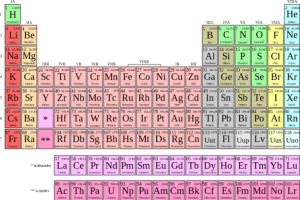Playlist
Show Playlist
Hide Playlist
Electrons – Introduction to Chemistry
-
Slides 01 Chemistry Basics Le Gresley.pdf
-
Download Lecture Overview
00:00 So when the structure of electrons or the atom was established, we knew that electrons were spinning around the outside. At least that was the theory. There was some sort of Newtonian planetary model where effectively the protons – the positive charge on the protons – held the electrons effectively via a simple harmonic force: centripetal acceleration, constantly holding them in the same way a satellite would orbit round a planet. 00:30 However, this rather simplistic model, which implied that electrons existed only as particles, was fundamentally flawed by the question: if positive charges attract negative charges – and we know they do, opposites attract – why don’t electrons crash into the nucleus? So why is it, like for example we see satellites orbit the Earth eventually slowing down and having lower and lower orbits until, eventually, losing their orbital stability and crashing into the ocean? Why do you not see electrons crashing into the proton-rich nucleus? This was a problem. So let’s have a look. We’ve got here in the case of 35Cl and 37Cl the same number of electrons and the same number of protons. We’ve got here though, in the case of each of our isotopes, a different number of neutrons: 18, 19 and 20. 01:35 So, as I talked about in the previous slide, if we have a positively-charged nucleus, why isn’t the negative charge of the electron result in the electron itself moving towards the nucleus itself? What stops the electrons from crashing into the nucleus? And this is the basis of quantum mechanics: the understanding that energy exists in small discrete packets. 02:03 And it was the Danish physicist Niels Bohr who came up with a solution to this issue of electrons not actually ending up crashing into the nucleus in the early 20th century. 02:17 And he put forward a couple of ideas. The amount of energy which an electron has determines how far away it is from the nucleus. In other words, the more energy it has the further away it is from the grasp of the positive charge. He also suggested that electrons could only be at certain specific distances from the nucleus. And whereas my analogy earlier of a satellite orbiting around a planet means that it could technically exist at a number of different altitudes away from the Earth, in this particular case we’re saying that quantised energy means that electrons can only exist at certain discrete distances away from the nucleus of an atom. So to use an analogy here of electrons and quantisation of energy, we’ll take the example of a staircase which is shown on the board. 03:15 A person shown on the board moves from one step to the other but they can only be on one step at a time and the higher up the staircase they are, the greater the amount of potential energy they have with respect to the ground. This, if you recall, is the very basic level of understanding for potential energy = mass × gravity × height. 03:41 Also you can only move one step at a time. It is not possible to move more than one step at a time. And that, as shown here, means that your movement from 4 to 2 is forbidden but your movement from 3 to 2 is allowed. So the movement of a person up a single step or down a single step is permitted but more than that is not.
About the Lecture
The lecture Electrons – Introduction to Chemistry by Adam Le Gresley, PhD is from the course Chemistry: Introduction.
Included Quiz Questions
Complete the following statement. According to the Rutherford-Bohr model, electrons are moving ...
- ... in circular orbitals around the nucleus.
- ... in straight lines passing through the center of the nucleus.
- ... in straight lines crossing each other near the nucleus of the atom.
- ... in zig-zag paths.
- ... away from the nucleus.
Which factor determines the spatial position of an electron in an atom?
- Amount of energy that the electron has
- Charge of the electron
- Mass of the electron
- Mass of the nucleus
- Number of protons in the nucleus
Which of the following statements is WRONG about the Bohr model of an atom?
- In an atom, revolving electrons are bound to the nucleus through gravitational forces.
- Electrons revolve around the nucleus without losing energy.
- The distance of a revolving electron from the nucleus is defined by the energy state of that particular electron.
- An electron can jump from one orbital to another by gaining or losing the energy.
- Electrons are moving at a certain discrete set of distances from the core without losing any energy.
Customer reviews
5,0 of 5 stars
| 5 Stars |
|
5 |
| 4 Stars |
|
0 |
| 3 Stars |
|
0 |
| 2 Stars |
|
0 |
| 1 Star |
|
0 |




